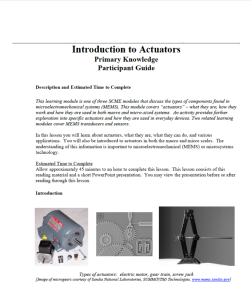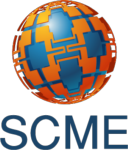Introduction to Actuators Learning Module

Module Description:
This module, from Support Center for Microsystems Education (SCME), provides an overview of actuator devices, including "what they are, how they work and how they are used in both macro and micro-sized systems." This module is divided into the following four units: Pre-test (Knowledge Probe), Introduction to Actuators Primary Knowledge (PK) unit, Activity - What are Actuators, and Final Assessment.
Module Contents:
The module includes four instructor guides, four participant guides, and a presentation. PDF and DOC versions are provided for all of the guides. The included guides are Introduction to Actuators Primary Knowledge, Introduction to Actuators Learning Module, an activity, and a final assessment. Instructor guides include additional content such as instructor notes and questions and answers.
Introduction to Actuators Primary Knowledge is an instructional unit with the following objectives:
- Describe what an actuator does.
- Explain how two different types of actuators work.
The following sections are included in this unit guide: Introduction, Objectives, Key Terms, Basic Concepts of Actuators, Thermal Actuators, Electric Actuators, Mechanical Actuators, MEMS Actuators, and more.
In the What Are Actuators Activity, students gain "a more in-depth understanding of actuators, the different types of actuators, and the differences and similarities between macro and micro-sized actuators." The activity includes the following objectives:
- Compare and contrast actuators and transducers.
- Explain how two different types of actuators work.
- Identify the micro-equivalent of two macro-sized actuators.
The Introduction to Actuators Final Assessment includes eight questions and is intended to be given to students at the completion of the module.
A Presentation is also provided that includes a unit overview and information about different types of actuators. The presentation is provided in both PDF and PowerPoint formats.
For orientation purposes Actuators_PK_IG.pdf is included as a separate attachment and offers a sample of the type of material included in this module.
Below is a list of the files included in the .zip attachment. The size of each file is included in parenthesis.
Introduction to Actuators Learning Module (26 files, 6.9MB)
- Instructor Guides
- Docs
- What are Actuators? Activity Instructor Guide (Actuators_AC_IG_May2017.docx 101 KB)
- Introduction to Actuators Final Assessment Instructor Guide (Actuators_FA_IG_May2017.docx 117 KB)
- Introduction to Actuators Learning Module (Actuators_KP_IG_May2017.docx 146 KB)
- Introduction to Actuators Primary Knowledge Instructor Guide (Actuators_PK_IG_May2017.docx 857 KB)
- PDFs
- What are Actuators? Activity Instructor Guide (Actuators_AC_IG.pdf 132 KB)
- Introduction to Actuators Final Assessment Instructor Guide (Actuators_FA_IG.pdf 100 KB)
- Introduction to Actuators Learning Module (Actuators_KP_IG.pdf 125 KB)
- Introduction to Actuators Primary Knowledge Instructor Guide (Actuators_PK_IG.pdf 856 KB)
- Docs
- Participant Guides
- Docs
- Activity - What are Actuators? Participant Guide (Actuators_AC_PG_May2017.docx 127 KB)
- Introduction to Actuators Final Assessment Participant Guide (Actuators_FA_PG_May2017.docx 105 KB)
- Introduction to Actuators Learning Module (Actuators_P1_KP_PG_May2017.docx 149 KB)
- Introduction to Actuators Primary Knowledge Participant Guide (Actuators_PK_PG_May2017.docx 865 KB)
- PDFs
- Activity - What are Actuators? Participant Guide (Actuators_AC_PG.pdf 108 KB)
- Introduction to Actuators Final Assessment Participant Guide (Actuators_FA_PG.pdf 94 KB)
- Introduction to Actuators Learning Module (Actuators_P1_KP_PG.pdf 123 KB)
- Introduction to Actuators Primary Knowledge Participant Guide (Actuators_PK_PG.pdf 851 KB)
- Docs
- Presentation
- Introduction to Actuators (Actuators_presentation.pdf 1.3 MB)
- Introduction to Actuators (Actuators_presentation.pptx 620 KB)
About this Resource


Comments